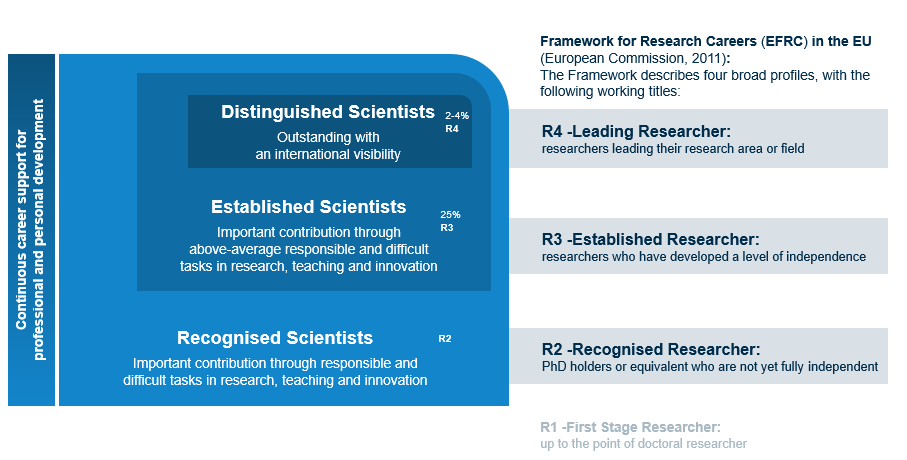Career Paths besides Professorships for Permanent Academic Staff at KIT
Researchers make a vital contribution to research, teaching as well as innovation and transfer at KIT.
In an environment that is changing ever more rapidly and facing unique challenges due to crises, they distinguish themselves through flexibility, strong professional and personal competencies, and the ability to adapt to a dynamic world. These qualities enable them to continue driving KIT forward in program-oriented research with state-of-the-art facilities, scientific excellence, and outstanding teaching.
KIT offers permanent researchers career opportunities beyond professorships, thereby promoting systematic competence development across three levels (see below). The introduction of the career system for permanent academic staff at KIT makes a significant contribution to the planning of individual career paths and increases visibility.
Accordingly, it strongly supports the proactive shaping of personal development as well as the compatibility of family life and an academic career. The career system offers an opportunity to make outstanding achievements visible and to recognize them appropriately.
The career system is applied through personal discussions with one’s supervisor. By outlining the development of both subject-specific and interdisciplinary competencies at each stage, an individual’s level of competence can be described using real-life situations. This allows the identification of development potential and the derivation of suitable measures.
Shape Your Academic Career at KIT
In this career system, three development stages can be mapped, which are compatible with the R-levels of the European Commission. These three stages are:
Level 1: Recognised Scientist
Recognised Scientists are engaged in scientific work and thus make an important contribution to KIT as an internationally visible and recognized research university. All researchers who have successfully mastered the evaluation procedure for permanent staff members receive the status of Recognised Scientists. They will be offered development opportunities in terms of deepening their expertise (job enrichment) and expanding their responsibilities (job enlargement).
Level 2: Established Scientist
In addition to taking on responsibilities and, if applicable, leadership roles, outstanding subject-specific achievements can also be criteria to be appointed as an Established Scientist. During development discussions with their supervisor, researchers can explore the prospects of advancing to this level. If needed, the supervisor may assist in preparing the necessary documents for the internal selection process within the division. This level is intended to have approximately one quarter of the permanent researchers.
Level 3: Distinguished Scientists
Distinguished Scientists are internationally outstanding with exceptional visibility and impact within the scientific community. As with previous levels, the prospects for advancement to Distinguished Scientist can be discussed during development meetings with one’s supervisor. After submitting the application documents, the Executive Board makes the final decision on admission to this development level. Only about 4 percent of researchers with permanent contracts are intended to be designated as Distinguished Scientists.
What qualifications are necessary to participate in the career system?
How do I apply and who is responsible for the selection?
It is recommended that, prior to the application process, a development meeting is held with your supervisor to jointly plan the application for the career system.
Requirements for participation in the selection process for Established Scientists include:
- The support of the direct supervisor
- A written endorsement from the head of the institute
- One external evaluation of the scientific performance
The selection of Established Scientists takes place within the respective division. A divisional committee, including a representative for equal opportunities, reviews the applications twice a year and verifies compliance with the formal criteria. Subsequently, the candidates are discussed in the Division Council (BR) and formally confirmed by the Head of Division.
Requirements for participation in the selection process for Distinguished Scientists include:
- The support of the direct supervisor
- A written endorsement from the head of the institute
- Two external evaluations of the scientific performance
The selection of Distinguished Scientists follows a synchronized, cross-divisional process that takes place once a year. A divisional committee, including a representative for equal opportunities, first verifies compliance with the formal criteria. The candidates are then discussed in the Heads of Divisions`s Meeting (BLR) and subsequently in the Executive Plus Meeting (PS+). A decision proposal is prepared for the PS committee, which makes the final decision regarding admission to the Distinguished Scientist career level. The newly appointed Distinguished Scientists are promptly announced in the Senate. This career level is intended for a highly select group within KIT, only about 20-40 appointed scientists in total at KIT.
The involvement of a representative of the Equal Opportunities Officer in the divisional committees is intended to ensure that aspects of equal opportunities are duly considered in the selection process.
All documents required for the application process are available in the internal download area.
Who is the designated contact person?
Is the consent of my supervisor required for participation?
Where can I find measures for personal development?
At KIT, there are training opportunities offered by various providers, such as the Center for Advanced Technological and Environmental Training (FTU), Human Resources Development and Vocational Training (PEBA, or the Karlsruhe House of Young Scientists (KHYS). In addition, external training opportunities may also be of interest.

